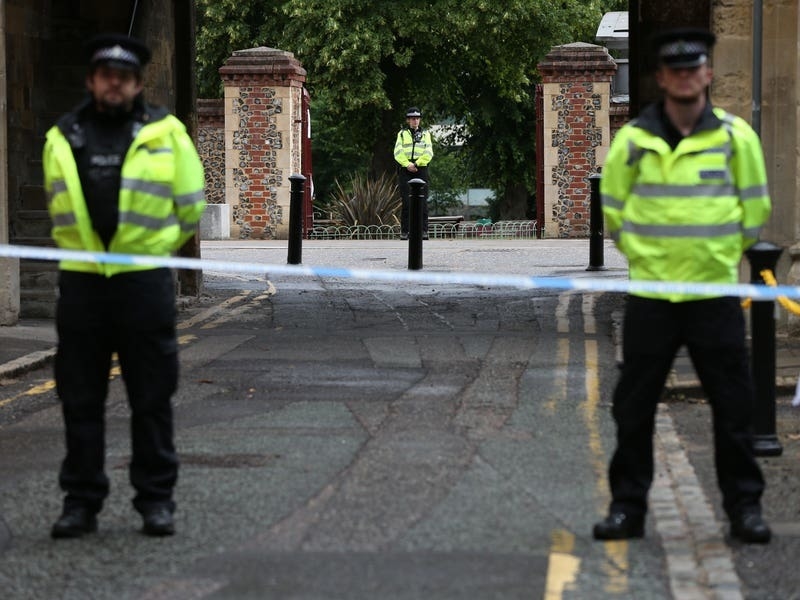For much of his long and distinguished career in the police force, John de Carteret photographed numerous murder crime-scenes in the hunt for criminals.
Now in retirement, he is still using his camera to help capture killers – albeit of the insect variety.
‘I’ve been turning up at Asian hornet nest sites to photograph and video everything using my residual photographic skills,’ says Mr de Carteret, who worked for the States police for 32 years before retiring in 2008.
‘We need to observe Asian hornets’ patterns of behaviour, the nest structure and the nest-building process undertaken by the queens, so that we can learn more about them.’
Asian hornets are predatory insects which are understood to feed on almost every other pollinator up to dragon-fly size.
They colonised France in little more than a decade and were first spotted in Jersey in August 2016.
Last year, around ten large secondary Asian hornets’ nests were found and destroyed in the Island and this year, five embryonic ‘start-up’ nests have been identified.
‘Asian hornet queens have started to come out of hibernation over the past two weeks and they have been building start-up nests,’ explains the 64-year-old, who is vice-president of the Jersey Beekeepers’ Association and looks after three honey-bee hives in his garden in St Saviour.
‘The Asian hornet start-up nests are really small – golf-ball size.
‘One was found at Maufant which I destroyed. A nest at St Lawrence and a nest at La Mare Wine Estate’s vineyards were both destroyed, and we are monitoring two nests in St Saviour with a view to destroying them at the appropriate time.’
Asked why those two nests had not yet been eradicated, he said: ‘There is very little known about the habits of these creatures, so myself, beekeeper Bob Hogge and other volunteers are monitoring these nests, and passing on the information we collect to the Environment Department.
‘And I’m recording a daily video diary of one of the nests. This includes the activities of the queen there, the development of the larvae inside the nest and the process the queen is following in building the nest – I’m on day 20 of the diary.’
He has even started a YouTube channel dedicated to Asian hornets.
‘Researchers in Spain and academics in the UK who are actively engaged in research to combat Asian hornets asked me to put my videos on YouTube so they could view them, so last weekend I created a YouTube channel called the Jersey Asian Hornet Diary.’
In 2016, Jersey beekeeper Bob Hogge developed a unique Asian hornet tracking system using paint. He lightly dabbed several Asian hornets with paint after trapping them in small cylinders, and this technique has helped them monitor their flight paths and decipher the whereabouts of nests.
Once a nest has been tracked down, Mr de Carteret puts the skills he learnt as a detective in the scenes of crime department to use, to document the appearance and behaviour of these inhospitable insects.
‘For 25 years of my career in the police I was in the scenes of crime department and I also spent a year on courses for all different aspects of photography with the police – surveillance, crime scene and fingerprint photography.
‘And I was the last locally qualified fingerprint expert in Jersey, so I have an eye for detail. I did a lot of macro [extreme close-up] photography for the police and that’s one of the things I’m doing with the Asian hornets.’
He also maps out the location of Asian hornet nests using GPS positioning and Google Maps.
‘Last year I superimposed the positions of where Asian hornets were captured and where we subsequently found the nests, to assist our tracking and trapping methods.’
He regularly ventures to within inches of a nest, yet surprisingly, Mr de Carteret – who received the Environmentalist of the Year Group award on behalf of the Jersey Beekeepers’ Association at last year’s Pride of Jersey Awards – has never been stung.
‘It’s not practical for me to put on protective equipment because I couldn’t operate the camera manually otherwise.’
He was almost caught off-guard by an emerging swarm of Asian hornets in woodland near Grouville last year.
‘I was video recording a nest which the pest controllers were dealing with and I entitled the video “I ran”. The nest had fallen out of a tree and broken open, but unlike the pest controllers I didn’t have a protective suit on, so I ran as fast as I could out of the wood to safety.’
A solitary Asian hornet’s sting can pack a considerable punch, but the real danger is if they swarm.
‘That’s because Asian hornets seem to have a far greater sense of collective responsibility for defending their nest than other insects,’ explains Mr de Carteret, who is also a volunteer in the archaeological section of the Société Jersiaise.
‘If you were to go near one of the big, secondary nests which the Asian hornets will try to build later in the summer and you get stung, that hornet would release an attack pheromone and you would get stung lots of times by a swarm. In France there have been a number deaths attributed to Asian hornet stings.’
According to Mr de Carteret, the other danger is that this invasive species could have a detrimental impact on crop pollination because of their propensity to prey on honey bees and many other pollinators.
‘There are about 420 bee hives in Jersey, so potentially we could lose a high proportion of these due to the Asian hornets predating on honey bees, which will make Jersey honey even more scarce. However, it is important to note that contrary to popular belief, they do not only prey on honey bees, but lots of other pollinators.’
Before joining the police, Mr de Carteret worked for six years in an architect’s office, which opened an unexpected door to a career on the force.
‘I didn’t know anything about photography and I didn’t like blood, but I came into the police from that architectural background, so I brought that precision drawing skill into the force,’ he explains.
‘That is why I ended up in the scenes of crime department. In the early 1980s there were a series of murders and I was approached to produce architectural-quality drawings of murder scenes – and I soon found myself working in that department.’
Among the many high-level criminal cases he worked on was the Newall murders.
Roderick Newall spent 13 years behind bars for murdering his parents Nicholas and Elizabeth to inherit a fortune, while his brother, Mark, was jailed for just over three years for conspiring to cover up the killing.
‘I took the famous pictures of the Newalls’ house, which looked like the Marie Celeste when the brothers disappeared, with just food left on the table.
‘I took nearly a thousand pictures at the property,’ adds Mr de Carteret, who during his police career was commended by the force for his work on many major criminal cases – as well as for solving the mystery of a spate of break-ins.
‘I happened to be off-duty in a local hardware shop when two youths came in wanting to buy a crowbar and what would usually have been some fairly innocent tool purchases. But as a result of my noting this and following it through, it turned out they were the people who had committed these break-ins.’
He has urged Islanders to show a similar level of vigilance where Asian hornets are concerned.
‘The phrase I’m trying to get out now is for people to “look up”. Look up in your sheds, garages, porches, outbuildings and farm buildings – including any overhangs – and if you see what you think is a little straw-coloured ball, contact us because it could well be an Asian hornet’s start-up nest.
‘By identifying them at this stage, you can help us stop a queen hornet going on to create a nest of up to 6,000 Asian hornets later in the summer.’
- Anyone who thinks they may have spotted an Asian hornet nest or an Asian hornet should contact the Environment Department on 441600, or email environment@gov.je.






